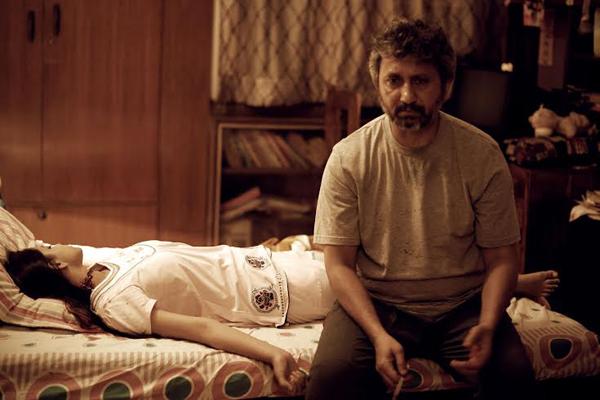 Images: Stills from Talvar and Rahasya
Images: Stills from Talvar and Rahasya
What lies beneath
Cinema reflects society they say. But society is also reflected in films. Youngsters copy follow their celluloid icons blindly often. Bollywood cinema is also generously inspired by acts of real crime and not just of great lives. What impact does it have on people in real life? Shoma A. Chatterji probes.
Two celluloid representations of true crime, namely Talvar and Rahasya based on the murder of Arushi Talwar raises ethical questions such as – whether such films enlighten, inform and educate or whether they can impact negatively on viewers specially of the younger generation.
Are they made to exploit the element of sensationalism or are they made to exploit the tragedy and titillate the audience as voyeurs? The censors have passed these films and so they cannot be stopped from public exhibition. In this ambience, it is necessary to question the making of such films. These films suggest a repeat celluloid exploitation of a rare human tragedy. The Arushi Talwar case remains inconclusive till date. Is it ethnical to make a film that deals with a case that awaits the final hammer to fall?
These two are not the only films inspired by true crime. Other notable ones are – BlackFriday, No One Killed Jessica, Ankur Arora Murder Case and the soon-to-be-released Khairlanjichya Mathyavar in Marathi based on the terrible Khairlanji massacre of a Dalit-turned-Buddhist family by right-wing Hindus on 29th September 2006.
According to journalist Sonali Joshi Pitale, director Raju Meshram is worried about the prospects of Khairlanjichya Mathyavar. Bhaiyalal Bhotmange, the lone survivor of the massacre, has filed a case stalling the film’s release. “They have shown me in poor light, as a coward and drunkard. Also, my daughter was not romantically involved with anyone. They did not take my permission before making the film. If released, it will mislead the audience. I don’t want any compensation from them,” he says.
Bhaiyyalal Bhootmange’s wife Surekha, 44, daughter Priyanka, 18, sons Roshan, 23 and Sudhir, 21, were first stripped naked, then dragged from their hut to the choupal 500 meters away and hacked to death by the entire village of so-called upper-castes in Bhandara district of Maharashtra.
Meshram says he did not feel the need to take permission. “Bhaiyalal has no patent on this story — all the information and pictures are available online. We showed him the film and he was happy about it. A day before its release, he filed a case against us. I am willing to put up a disclaimer saying he is not a drunkard and the pictures are morphed but he is in no mood to sort out the issue,” says Meshram, adding that he has incurred heavy losses as he has spent a lot of money on promotions.
63-year-old Amarnath Grover’s son Neeraj, a top ranking executive in a television software company in Mumbai, was hacked to death by a naval officer on the instigation and assistance of his girlfriend, an aspiring actress. Grover laments the lack of decency of filmmaker Ram Gopal Verma who made Not a Love Story because he did not care to even talk to him before deciding to make the film.
Fortunately, the film bit the dust. Adds Grover,“Just before the film was released in 2011, someone came forward to help me claim compensation from the director but I declined. No amount of money could have brought my son back. I just wanted people to know how Neeraj was victimised. But the film twisted facts and the audience believed what they saw was a true account.”
Noted film critic Nandini Ramnath says, “It is perfectly alright and, indeed, common to make films on real-life crimes. It would be nice if filmmakers stuck to facts and did not sensationalize events. Feature films deal with fiction, and filmmakers enjoy the right to treat their material in any manner they choose, whether sensationalist or understated. Going to the theatres is a voluntary act. Filmgoers have the option of choosing not to buy tickets if they find trailers or songs offensive or objectionable. The idea that movies have a lasting impact is overstated. A film can be revisited on TV and in DVDs after it has completed its theatrical run, while TV clips deemed offensive and newspapers articles that are regarded as inflammatory also survive on the internet.”
Filmmaker and film teacher Oorvazi Irani states. “I feel when a real life incident is used to make a film the filmmaker has a responsibility as a creative artist to provide an insight and make the audience reflect about the reality of the crime fictionalised on film.. Had both Talvar and Rahasya done that, had the films told us what was not already told and shown on television as news, it would have made a difference and made an positive impact. A film is not news that projects reality but it aspires to make a statement about that reality. But then, news itself can have a viewpoint or a bias.”
Ekta Kapoor of Balaji Telefilms was compelled to withdraw her plan to air an episode on television she said was “inspired” by the Aarushi Talwar case. Aarushi’s mother implemented the National Commission for Protection Against Child Rights against Balaji Telefilms to prevent Kapoor from airing the episode prepared to go on air in 2008! A Ph.D. student at the University of Ontario raises questions on whether the filmmakers who choose to make fictionalised films on true crime want to exploit the sensational element or whether they wish to shed new light on the case or whether they wish to take arguments and unanswered questions forward.
Commenting on Raj Kumar Gupta’s No One Killed Jessica, her sister Sabrina said, “While making a film based on a real life incident, I feel it is important to seek approval from the family of the victim keeping their emotions in mind. Efforts must be made to stick to facts and not sensationalize them. I was involved with the film from day one and the script was sent to me for approval so I was not apprehensive about the content of the film.”
Senior Consultant Psychiatrist Dr. Sanjay Chugh says, “There are three ways of looking at the celluloid representation of true crime. The first is the film’s ability to make the audience feel the emotions expressed through the film which will establish a connect. Once this connect is established, the audience can relate, identify and react. The second way lies in the manner in which the story is unfolded by the script and the filmmaker.
“The third is the perspective the film offers. But how many directors are able or even willing to bring out these three elements of establishing this connect, deciding on a decent and objective way of narrating the story without sensationalizing it and finally, throwing a perspective that can be depended upon and that sheds light instead of making it sensational?”
Top Headlines
-
Entertainment
Valentyn Vasyanovychs To The Victory! wins 2025 TIFF Platform Award unanimously
September 26, 2025
-
Entertainment
Chlo Zhaos Hamnet Wins TIFF 2025 Peoples Choice Award
September 20, 2025
-
Entertainment
Sholay: Golden even after fifty years
July 04, 2025
-
Entertainment
War 2: Check out Hrithik Roshan, Jr NTR and Kiara Advani's new posters
June 26, 2025
-
Entertainment
LGBTQIA+: Icelandic film Odd Fish and Brazil's Baby win big at KASHISH 2025 film festival
June 12, 2025
-
Entertainment
Katrina Kaif named Maldives tourism global brand ambassador ahead of Modi's visit
June 10, 2025
-
Entertainment
'Queen marches to conquer': Deepika Padukone joins Atlee's AA22xA6 starring Allu Arjun after 'Spirit' exit
June 08, 2025
-
Entertainment
Dakota Johnson and Chris Martin, who were in on-and-off relationship, broke up: Reports
June 06, 2025
-
Entertainment
Sharmila Tagore to Alia Bhatt, India weaves cross-generational tale at Cannes 2025
May 28, 2025
-
Entertainment
Is Sandeep Reddy Vanga's cryptic 'feminism' post meant for Deepika Padukone? Neitzens think so
May 27, 2025


